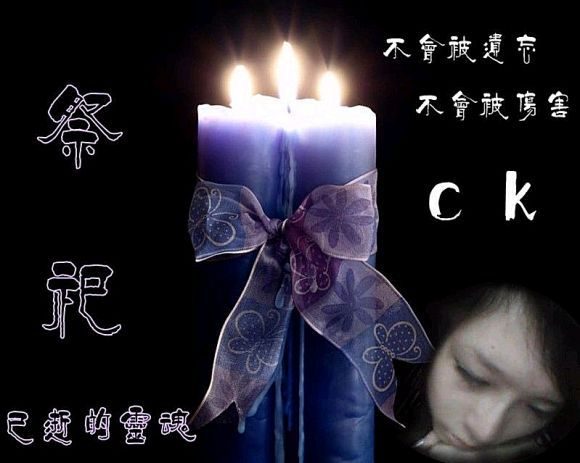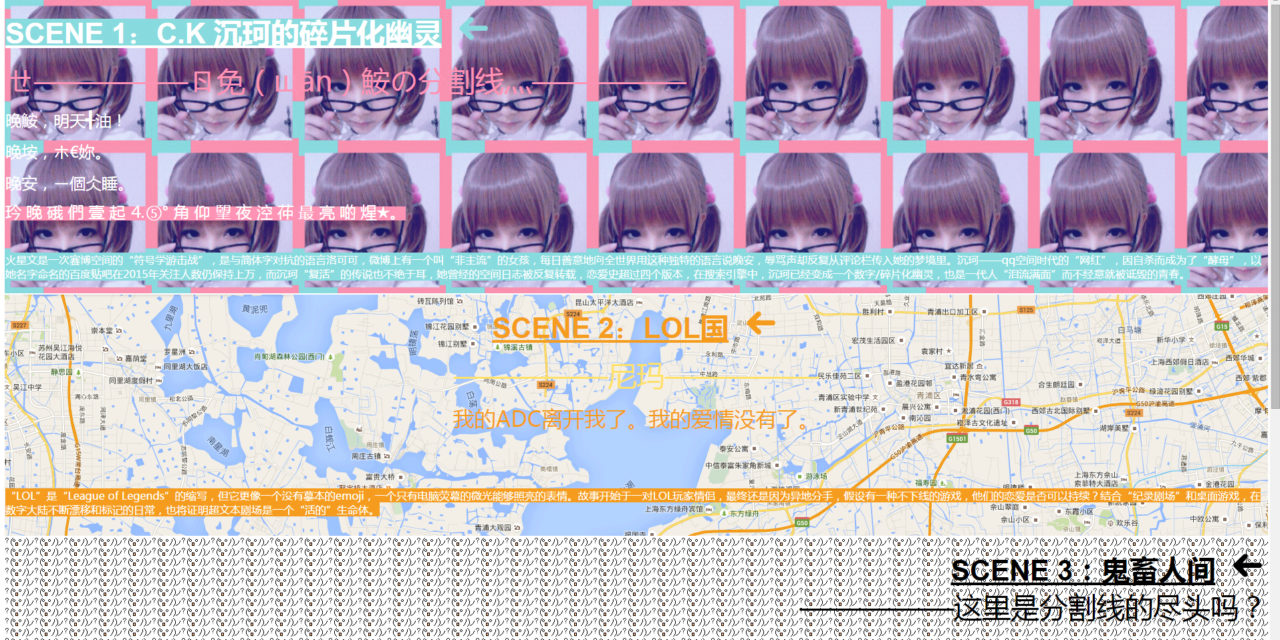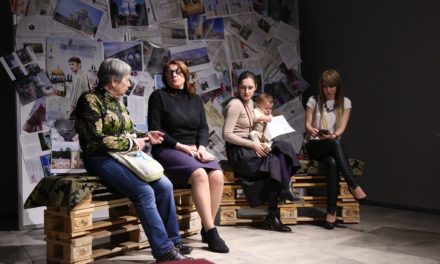Twenty years ago, it was inconceivable for people to meet without a physical encounter. But today, as the web browser has become a cyber theatre – a proscenium stage with a kind of “performance-action” taking place in the cyberspace behind its arch – when you subscribe to a blog or follow a tweet, you are signing up to your first spectator’s contract, which in time will be fulfilled with a subject in action.
As Peter Brook puts it, a man walks across an empty space whilst someone else is watching him, and this is theatre. In the same manner, the basic formula of cyber theatre can be defined as such: a mouse is dragged along a standalone digital interface, performing a series of orders and events, whilst its first spectator, namely the operator in front of the screen, is watching it. As early as the Windows ‘98 era, virtual scenography has demonstrated how people use digital interfaces as a “stage,” by changing wallpapers, icons, and mouse arrows. After inventing the mouse avatar, our contemporary Aeschylus created a second character for his tragedy, namely “My Computer,” or “the little lion of ESM antivirus software.” Eventually, the “Internet connection” moved cyber theatre out of the temple and turned it into a carnival for the masses.
At first, cyberspace used reality as its playscript and emerged in the form of a theatre of imitation and reproduction. Later, with the introduction of Web 2.0, cyberspace started to evolve beyond a theatre of simulation into – in Baudrillard’s terms – a field of “hyperreality.” Eventually, with its “return to off-line” (zaixian xiahua: literally, “re-offlin(e)-ise”), cyber theatre has substantiated itself as a space for public discourse with the mission to “reconstruct” collective imaginations. This is to say that cyberspace is translated into a template (a play script) for reality to alter and update itself, to eventually achieve a theatricalized society of “hyper-hyperreality.” This circular process occurs continuously and scatteredly across time-space, wherein cyber theatre represents the online rehearsal for a series of offline performances. These repeated rehearsals are the trial and error of future possibilities, and the preparation for positive interventions into reality. Hence, cyber theatre is defined by the action of actors (persons-in-action) who apply new rules and change the order of the cyberspace; it differs from cyber drama, which uses cyberspace simply for literary expression.
— — — — Here Is the Dividing Line — — — — (— — — — Zheli shi fengexian — — — —, 2015) is an example of cyber theatre that cybersquats a domain name to construct alternative online narratives. Documentary materials were extracted from various cyberspaces – including Q-zone, the LOL (League of Legends) online game, and Bilibili.com – to conduct theatrical discussions on its website, www.zhelishifengexian.org. Q-zone (QQ-zone), the teenage counterpart of blogs, was once used extensively across China. Compared to other BBS (Bulletin Board System) public forums, Q-zone attracted users from QQ’s instant messaging service with extremely high user loyalty and allowed its users to customise their spatial decoration to a certain degree. Hence it successfully differentiated itself as a personal, self-sovereign territory. It is also a more theatrical cyberspace. In the realm of the Internet, the “code” controls the means of information; like any other key in the world, its accessibility determines the degree of freedom in the cyberspace. As a result, QQ’s virtual scenery, provided with a semi-open source code, gave birth to a generation of “godmothers” and “godfathers” (popular idols) who could create distinct personalities using basic codes, and successfully embodied, characterised, and idolised their entities online. Once circulated online, their Q-zone diaries and status signatures transformed private matters into public legends.

— — — — Here Is the Dividing Line — — — — (2015), scene selection
Among them, the most remarkable case was that of “C.K. Chen Ke,” one of the first-generation internet celebrities since 2005. Her digital images and daily life trajectories (as updated online) were imitated by large number of “alternative” (fei zhuliu: literally, “non-mainstream”) followers; the music she recorded in her “bedroom recording studio” and her daily posts emanated an aura of cynicism, pessimism, and negativity that resonated with the dark, depressing tone of her Q-zone decorations, and together generated incommensurable theatrical resonance across the cyberspace.
Afterwards, some cyber minority groups active on Q-zone and QQ chatting groups, such as “Clan Shameiya” and “Clan Canxue,” re-introduced such totem-like cyber aesthetic offline (literally, “re-offlin(e)-ised” [zaixian xiahua]). They walked off the screens and down the streets, literally “embodying” (roushenhua) the spirit of Photoshop in their appearances, and turned into a phenomenon labelled as “SMART” (Shamate) by mainstream society. At the same time, “Martian language,” a form of cyber script popular among young netizens and “incomprehensible to terrestrials,” was rehearsing for a formal linguistic revolution. “Martian language” imitates the Rococo style of East Asian scripts and is composed of a semiological guerrilla of Chinese characters (both traditional and simplified), Japanese kanji, and rarely used punctuation. It is stylistically equivalent to a pompous dialogue in a classical drama. In 2008, however, all these movements either ended or failed with the announcement of C.K. Chen Ke’s “suicide.” Whether it was real or not, her suicide, as a media event, came to represent the symbolic “death” of youth for a whole generation.

— — — — Here Is the Dividing Line — — — — (2015), scene selection
Back in the early 2000s, the age of QQ chatrooms, “Meet or Not” was the leitmotif of most dramatic scenarios. “Meeting Offline” means getting out of character, like actors meeting offstage. Interestingly, even in offline meetings, actors would still address each other by their net names (character names), as if their images were still active on the stage (i.e. in the online chatroom). Hence, in reality, actors interact with dual identities, performing theatrical rituals in real life encounters. This is perhaps the earliest form of “hyper-hyperreality.” However, in recent years, the “Real Name System (Shi ming zhi)” policy enforced by the Chinese government has produced an operation of “anti-theatricality.” The policy disapproves of online anonymity or pseudonymity, which is the primary condition of identity construction in cyberspace, and without which cyberspace easily becomes a simulation of real life.
Back in the late 1990s, the digital migration wave was embedded in the common anxiety of “staying online or getting offline.” The anonymity of the early Internet confronted many people with crises of de-historicization and de-identification. Yet accompanying such crises were dramatic character developments in cyberspace: changing names and headshots in BBS, unmoderated posting (acting) and commenting (spectating) like in a digital performance, offering a new opportunity for freedom of expression after the “Democracy Wall” movement of 1978 in Beijing. But soon, the top-down strategy of the “Real Name System” in mainland China first covered the social networks with the introduction of Xiaonei Wang (later Renren Wang), a copycat (shanzhai) version of Facebook. For many users, the “Real Name System” took away the confusion of characterization and de-identification, and encouraged them to spend more time online, because the social networks looked “more real.” Yet it was precisely that “realness” that compelled “cyber theatre” into a stage of “anti-theatricality.”
In fact, it is necessary to distinguish between “non-theatricality” in pre-dramatic theatre and “anti-theatricality” in post-dramatic theatre. As an example of the latter, “cyber theatre” has witnessed such stylistic developments as documentary theatre and popular theatre. According to the “Theatre of the Oppressed” practitioner Augusto Boal, “theatre is a rehearsal for the revolution”; in cyberspace, such (documentary) theatre takes shape in the real speeches given by “Big V” users (public opinion leaders) and marginal Civil Rights activists, which trigger widespread circulation and commentary online and, in some cases, even directly lead to performance action offline — for example, the ALS Ice Bucket Challenge. In contrast, the “non-theatricality” of pre-dramatic theatre is spreading across WeChat Moments (a social-networking function of WeChat, “friends’ circle” [pengyou quan]) right now.
The real concern about WeChat is not that it restricts performance-action trajectories to a private realm (i.e.: only your friends can see what you post), but that it risks gradually degenerating into a live broadcast of reality. This degeneration necessitates a strategy to “re-dramatize” our cyber identity, to recreate an extra character layer in WeChat, to use Moments as a “second life” domain. We can witness to this strategy operating presently in our daily life: creating virtual images and sceneries using Photoshopping apps, creating fictional “coordinates” using internet positioning functions (GPS), or creating hypertext narratives using personalised font design apps. At an early stage, these attempts to reinforce virtual reality manifest themselves in the form of personal taste-oriented, micro-ritualistic theatre, yet their potential for future evolution remains to be seen.

— — — — Here Is the Dividing Line — — — — (2015), desktop virtual pet
Besides, with their practice of micro-mobilization, both official accounts and group functions in WeChat can play an “agora effect”: a subscription-based newsletter can collect millions of page views, and viral videos such as “Uniqlo Changing Room” (2015) and “Tianjin Explosions” (2015) can reach a massive audience at rocket speed. I attempted to create a “cyber theatre” in a WeChat group: using a QR code and a group invitation, I was able to gather 176 audiences and actors almost instantly. It was a meta-discussion of cyber theatre, i.e. “what is cyber theatre”, with sub-narratives such as “a company rehearsing Journey to the West” and “aliens looking for UFO” immersed in self-initiated audience participation in the form of changing headshots and usernames, uploading pictures, videos, and recordings, and sharing locations. The performance culminated in a collective action of “flooding the screen” – a ritual that symbolises a DoS (Denial of Service) attack – which resulted in multiple incidents of overfilled mobile storage, and hence automatic shut-down. The above practice, both as a media event and a “cyber theatre” performance/action, demonstrated that even under surveillance WeChat is still a valid theatrical space for public discourse and performance actions in China. Meanwhile, the collapse of Internet terminals, as above, is a metaphor. It can be read as a bottom-up digital sit-in protest, as well as a top-down act of punishment.
The “cyborg” characters in William Gibson’s Neuromancer (1984), who despise the human body and atomic fields, are perhaps the first cyber actors, whereas the “cyber cowboys” who steal digital information suffer from the cruellest punishment: to be unable to connect to the Internet. The “Chinese Firewall,” a digital metaphor of the “Great Wall,” is at the same time an allegory. Our “Internet” is actually a “Local Area Network (LAN)” within a giant theatricalized country, and the various “circumvention technologies” (fan qiang, literally “Climb over the Wall”) to illegally bypass the blocking and filtering of censored information are active attempts to break through the closed theatre space. Such attempts are the metadrama of Chinese cyber theatre. Besides Weibo, WeChat and other heavily censored cyber domains, some non-social networking websites and apps with a relatively smaller user base can also become active domains for cyber theatre. For example, the “search engine bombs” on Baidu and other mainstream search engines in China manipulate what appears under the “keyword” search by heavily linking unrelated websites to certain search terms. After C.K. Chen Ke’s suicide, restless fans even fabricated evidence of her resurrection in search engines.

— — — — Here Is the Dividing Line — — — — (2015) . C.K. Chen Ke’s online memorial
Certain positioning service apps can also be used as tools to testify to the Situationist “Theory of the Derive” or to create a cyber flash mob in particular domains. For instance, in Jie Pang (literally “by the street”), an app similar to Foursquare, users can repeat “check-in” actions to win symbolic “mayorships” and exchange them for coupons or discounts.
More actions of cyber theatre must have been happening beyond our field of vision, in private mailing groups, Internet games, or grey areas of the Internet, such as the deep web and dark web. Perhaps, all these phenomena can be read as a kind of revelation. It is like that couple of netizens in the chatroom, who were deciding whether to “meet or not”. When they take on again their dual identities as an actor and a spectator, a new discourse, a new territory will perhaps open up in each other’s mind.
Translation: Selena Lu
This article was originally published on LEAP French Edition 2015 Light (in Chinese with French translation). Translated into English and republished with permission.
This post was written by the author in their personal capacity.The opinions expressed in this article are the author’s own and do not reflect the view of The Theatre Times, their staff or collaborators.
This post was written by Sun Xiaoxing.
The views expressed here belong to the author and do not necessarily reflect our views and opinions.


















